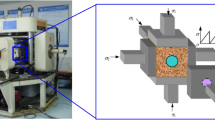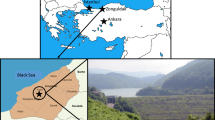Abstract
Accurate estimation of rockfall trajectory and motion behaviors is essential for rockfall risk assessment and the design and performance evaluation of preventive structures. Numerical simulation using discontinuous deformation analysis (DDA) is effective and helpful in rockfall analysis. Up to now, there have been many reports on application of two-dimensional (2-D) DDA programs. In this paper, the major advantages of rockfall analysis using 2-D and extensions to three-dimensional (3-D) analysis are presented. A practical 3-D DDA code is demonstrated to be capable of simulating free falling, rolling, sliding, and bouncing with high accuracy. Because rockfall trajectories and motion behaviors can be described as combinations of these four types, this demonstration indicates that the implemented code is capable of providing reliable rockfall analysis. Finally, specific tests are conducted to compare 2-D and 3-D DDA rockfall analysis in predicting trajectory and dynamic behavior. The results indicate that 3-D DDA simulations are more appropriate for rough tree-laden inclined slopes in providing detailed spatial distribution, whereas 2-D DDA simulations have better efficiency for slopes dominated by valleys and ravines. These results can help in selecting the appropriate DDA simulation for rockfall analysis.
























Similar content being viewed by others
References
Agliardi F, Crosta G (2003) High resolution three-dimensional numerical modelling of rockfalls. Int J Rock Mech Min 40:455–471
Agliardi F, Crosta GB, Frattini P (2009) Integrating rockfall risk assessment and countermeasure design by 3D modeling techniques. Nat Hazards Earth Syst Sci 9:1059–1073
Azzoni A, La Barbera G, Zaninetti A (1995) Analysis and prediction of rock falls using a mathematical model. Int J Rock Mech Min 32:709–724
Barret RK, Pfeiffer T (1989) Rockfall modeling and attenuator testing. US Department of Transportation, Federal Highway Administration, Final Report
Bozzolo D, Pamini R, Hutter K (1988) Rockfall analysis—a mathematical model and its test with field data. In: 5th International symposium on landslides. Balkema, Rotterdam, pp 555–563
Chau KT, Wong RHC, Lee CF (1998) Rockfall problems in Hong Kong and some new experimental results for coefficient of restitution. Int J Rock Mech Min Sci 35(4–5):662–663
Chau KT, Wong R, Wu J (2002) Coefficient of restitution and rotational motions of rockfall impacts. Int J Rock Mech Min 39:69–77
Chen GQ (2003) Numerical modeling of rock fall using extended DDA. Chin J Rock Mech Eng 22(6):926–931
Christen M, Bartelt P, Gruber U (2007) RAMMS—a modeling system for snow avalanches, debris flows and rockfalls based on IDL. PFG Photogrammetrie-Fernerkundung-Geoinformation 4:289–292
Crosta GB, Agliardi F (2004) Parametric evaluation of 3D dispersion of rockfall trajectories. Nat Hazards Earth Syst Sci 4:583–598
Crosta G, Agliardi F, Frattini P, Imposato S (2004) A three dimensional hybrid numerical model for rockfall simulation. Geophys Res Abstr 6
Cundall PA, Strack ODL (1979) A discrete numerical model for granular assemblies. Geotechnique 29:47–65
Descoeudres F (1997) Aspects géomécaniques des instabilités de falaises rocheuses et des chutes de blocs. Publications de la Société Suisse de Mécanique des Sols et des Roches 135:3–11
Descoeudres F, Zimmermann T (1987) Three-dimensional dynamic calculation of rockfalls. In: Sixth international congress on rock mechanics. International Society for Rock Mechanics, Montreal, pp 337–342
Dimnet E (2002) Mouvement et collisions de solides rigides ou déformables. Ph.D. thesis, Ecole Nationale des Ponts et Chaussées, Paris
Dorren LKA (2003) A review of rockfall mechanics and modelling approaches. Prog Phys Geogr 27(1):69–87
Dorren LKA, Seijimonsbergen A (2003) Comparison of three GIS-based models for predicting rockfall runout zones at a regional scale. Geomorphology 56:49–64
Dorren LKA, Maier B, Putters US, Seijmonsbergen AC (2004) Combining field and modelling techniques to assess rockfall dynamics on a protection forest hillslope in the European Alps. Geomorphology 57:151–167
Dorren LKA, Berger F, Le Hir C, Mermin E, Tardif P (2005) Mechanisms, effects and management implications of rockfall in forests. For Ecol Manag 215:183–195
Frattini P, Crosta G, Carrara A, Agliardi F (2008) Assessment of rockfall susceptibility by integrating statistical and physically-based approaches. Geomorphology 94:419–437
Giani GP (1992) Rock slope stability analysis. Taylor & Francis/Balkema, Amsterdam
Guzzetti F (2000) Landslide fatalities and the evaluation of landslide risk in Italy. Eng Geol 58:89–107
Guzzetti F, Crosta G, Detti R, Agliardi F (2002) STONE: a computer program for the three dimensional simulation of rock-falls. Comput Geosci 28:1079–1093
Hosoya S, Iwama T, Nakane M, Ito D, Ujihira M (2003) Study on the 3-dimensional simulation of rock fall along a slope. J Jpn Soc Eng Geol 44(1):25–35
Hungr O, Evans SG, Hazzard J (1999) Magnitude and frequency of rock falls along the main transportation corridors of southwestern British Columbia. Can Geotech J 36:224–238
Jonsson M (2007) Energy absorption of trees in a rockfall protection forest. Ph.D. thesis, ETH Zürich, Zürich
Labiouse V, Desceoudres F (1999) Possibilities and difficulties in predicting rockfall trajectories. In: Masuya H, Labiouse V (eds) Joint Japan-Swiss seminar on impact load by rockfalls and design of protection structures, Kanazawa, pp 29–36
Lambert S, Nicot F (2011) Rockfall engineering. Wiley/ISTE Ltd., New York/London
Lan H, Martin D, Lim C (2007) RockFall analyst: a GIS extension for three-dimensional and spatially distributed rockfall hazard modeling. Comput Geosci 33:262–279
Lied K (1977) Rockfall problems in Norway. In: Rockfall dynamics and protective works effectiveness. ISMES Publication no. 90, Bergamo, Italy, pp 51–54
Lin C, Amadei B, Jung J, Dwyer J (1996) Extensions of discontinuous deformation analysis for jointed rock masses. Int J Rock Mech Sci Geomech Abstr 33(7):671–694
Lisjak A, Spadari M, Giacomini A, Grasselli G (2010) Rockfall numerical modelling using a combined finite-discrete element approach. In: Proceedings of the symposium rock slope stability, Paris, France
Ma GC, Matsuyama H, Nishiyama S (2007) Study on analytical method for rockfall simulation. J Jpn Soc Civ Eng 63(3):913–922 (in Japanese)
Masuya H, Amanuma K, Nishikawa Y, Tsuji T (2009) Basic rockfall simulation with consideration of vegetation and application to protection measure. Nat Hazards Earth Syst 9:1835–1843
Meissl G (1998) Modellierung der Reichweite von Felsstürzen: Fallbeispiele zur GIS-gestützten Gefahrenbeurteilung. Ph.D. thesis, Institut f¨ur Geographie, Univ. Innsbruck
Ning Y, An X, Lü Q, Ma G (2012) Modeling rock failure using the numerical manifold method followed by the discontinuous deformation analysis. Acta Mech Sin 28(3):760–773
Nishimura T, Fukuda T, Kiyama H (2010) Numerical simulation of effects of slope micro-topography on rockfall trajectories. J Soc Mater Sci Jpn 59(3):199–204 (in Japanese)
Ohnishi Y, Yamamukai K, Chen GQ (1996) Application of DDA in rockfall analysis. In: Proceedings of the 2nd North American rock mechanics symposium, Montreal, QC, Canada, pp 2031–2037
Pfeiffer T, Bowen T (1989) Computer simulation of rockfalls. Bull Assoc Eng Geol 26:135–146
Ritchie AM (1963) Evaluation of rockfall and its control. In: Highway research record no. 17, pp 13–28
Schellenberg K (2009) On the design of rockfall protection galleries—an analytical approach for a performance based design. Südwestdeutscher Verlag für Hochschulschriften, Saarbrücken, Germany
Shi GH (1988) Discontinuous deformation analysis: a new numerical model for the statics and dynamics of block systems. PhD thesis, University of California, Berkeley, USA
Shi GH (2001) Three dimensional discontinuous deformation analysis. In: Proceedings of the 4th international conference on analysis of discontinuous deformation, Scotland, UK
Shimauchi T (2008) Study on verification of rockslide and rockfall simulation using numerical analysis. Ph.D. thesis, Kyoto University, Japan (in Japanese)
Shimauchi T, Ohnishi Y, Nishiyama S, Sakai N (2006) Study on verification of rockfall simulation using improved DDA considering the characteristics of velocity energy ratio at impact. J Civ Eng C 62(3):707–721 (in Japanese)
Shimauchi T, Nakamura K, Nishiyama S, Ohnishi Y (2009) Concerning the influence of velocity ratio and topography model on the result of rockfall simulation. In: Proceedings of the 9th international conference on analysis of discontinuous deformation, Singapore, pp 39–46
Spadari M, Giacomini A, Buzzi O, Fityus S, Giani GP (2012) In situ rockfall testing in New South Wales, Australia. Int J Rock Mech Min 49:84–93
Spang R, Sönser T (1995) Optimized rockfall protection by “Rockfall”. In: 8th International congress on rock mechanics, Tokyo, vol 3, pp 1233–1242
Stacey TR, Gumede H (2007) Evaluation of risk of rock fall accidents in gold mine stops based on measured joint data. J South Afr Inst Min Metall 107:345–350
Stevens WD (1998) Rocfall: a tool for probabilistic analysis, design of remedial measures and prediction of rockfalls. Master’s thesis, University of Toronto
Stoffel M, Wehrli A, Kühne R, Dorren LKA, Perret S, Kienholz H (2006) Quantifying the protective effects of mountain forests using a 3D simulation model. For Ecol Manag 225(1–3):113–122
Ueno S, Odagiri X, Ma GC (2001) An example of the DDA analysis focused on difference of the vegetation. In: Proceedings of the 36th symposium on rock mechanics, Tokushima, pp 2503–2504 (in Japanese)
Ushiro T, Kusumoto M, Shinohara S, Kinoshita K (2006) An experimental study related to rockfall movement mechanism. Doboku Gakkai Ronbunshuu F 62(2):377–386
Van Dijke J, van Westen C (1990) Rockfall hazard: a geomorphological application of neighbourhood analysis with ILWIS. ITC J 1:40–44
Varnes DJ (1978) Slope movement types and processes. In: Schuster RL, Krizek RJ (eds) Landslides analysis and control. Transportation Research Board, National Academy of Science, Washington, DC, Special Report 176, pp 11–33
Volkwein A, Schellenberg K, Labiouse V, Agliardi F, Berger F, Bourrier F, Dorren LKA, Gerber W, Jaboyedoff M (2011) Rockfall characterisation and structural protection—a review. Nat Hazards Earth Syst 11:2617–2651
Wang Y (2009) Three-dimensional rock-fall analysis with impact fragmentation and fly-rock modeling. Ph.D. thesis, University of Texas at Austin, Austin
Wang Y, Tonon F (2009) Modeling Lac du Bonnet granite using a discrete element model. Int J Rock Mech Min Sci 46:1124–1135
Wang Y, Tonon F (2010) Calibration of a discrete element model for intact rock up to its peak strength. Int J Numer Anal Methods Geomech 34(5):447–469
Wang Y, Tonon F (2011) Discrete element modeling of rock fragmentation upon impact in rock fall analysis. Rock Mech Rock Eng 44:23–35
Wu J, Ohnishi Y, Nishiyama S (2005) A development of the discontinuous deformation analysis for rock fall analysis. Int J Numer Anal Methods 29(10):971–988
Yang M, Fukawa T, Ohnishi Y, Nishiyama S, Miki S, Hirakawa Y, Mori S (2004) The application of 3-dimensional DDA with a spherical rigid block for rockfall simulation. Int J Rock Mech Min 41:1–6
Zheng L, Chen GQ, Zen K, Kasama K (2011) The method of slope modelling for rockfall analysis using 3D DDA. In: Proceedings of the 10th international conference on analysis of discontinuous deformation, Hawaii, USA
Zimmer VL, Collins BD, Stock GM, Sitar N (2012) Rock fall dynamics and deposition: an integrated analysis of the 2009 Ahwiyah Point rock fall, Yosemite National Park, USA. Earth Surf Proc Landf 37:680–691
Acknowledgments
The authors thank Dr. G. Shi for his great contribution to the DDA development and his diligent work on DDA programming. The program used in this study was extended from his original 3-D DDA code. This work was supported by JSPS KAKENHI Grant Number 22310113 and the Global Environment Research Found of Japan (S-8). Both financial supports are gratefully acknowledged. The authors are grateful to Prof. Antonio Bobet and the two anonymous reviewers for their critical suggestions and valuable comments.
Author information
Authors and Affiliations
Corresponding author
Rights and permissions
About this article
Cite this article
Chen, G., Zheng, L., Zhang, Y. et al. Numerical Simulation in Rockfall Analysis: A Close Comparison of 2-D and 3-D DDA. Rock Mech Rock Eng 46, 527–541 (2013). https://doi.org/10.1007/s00603-012-0360-9
Received:
Accepted:
Published:
Issue Date:
DOI: https://doi.org/10.1007/s00603-012-0360-9




